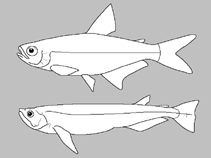Загрузить свой Фото и Видео
Изображение на GoogleNo image available for this species;
drawing shows typical species in Characidae.
Изображение на GoogleNo image available for this species;
drawing shows typical species in Characidae.
Классификация / Names народные названия | синонимы | Catalog of Fishes(род, виды) | ITIS | CoL | WoRMS | Cloffa
> Characiformes (Characins) > Characidae (Characins; tetras) > Stethaprioninae
Etymology: Astyanax: The name of Astyanax, Hector´s son in the Greek mythology (Ref. 45335); procerus: From the Greek adjective procerus, meaning tall, in reference the high body depth of the species.
Eponymy: Astyanax was the son of Hector in Greek mythology. See Homer’s Iliad for details. The reasoning for its use for a genus of characins is not explained. (Ref. 128868), visit book page.
Etymology: Astyanax: The name of Astyanax, Hector´s son in the Greek mythology (Ref. 45335); procerus: From the Greek adjective procerus, meaning tall, in reference the high body depth of the species.
Eponymy: Astyanax was the son of Hector in Greek mythology. See Homer’s Iliad for details. The reasoning for its use for a genus of characins is not explained. (Ref. 128868), visit book page.
Environment: milieu / climate zone / depth range / distribution range экология
; пресноводный донно-пелагический. Tropical
распространение страны | регионы FAO | Ecosystems | места находок | Point map | интродукции | Faunafri
South America: upper and middle rio Taquari-Antas and rio Jacuí, laguna dos Patos
system in Rio Grande do Sul, Brazil.
Size / Вес / Возраст
Краткое описание определительные ключи | морфология | морфометрия
членистые (мягкие) лучи спинного плавника (общее число) : 10 - 11; позвонки: 36 - 38. This species is distinguished from all congeners in the rio Uruguay basin, laguna dos Patos and rio Tramandaí systems by having the following characters: two humeral spots (vs. one in Astyanax eigenmanniorum, A. sp. aff. fasciatus, A. jacuhiensis, and A. laticeps); first humeral spot vertically elongate with upper portion wider portion narrow and curved, with a pronounced constriction at the junction of both portions (vs. present of oval shape spot with two brown vertical bars in humeral region in A. jacuhiensis, oval shape in A. laticeps and forming a uniform wedge in A. eigenmanniorum and A. henseli); anal fin with 8-23 branched rays (vs. 18 or less in A. rachypterygium and A.cremnobates, 23 or more in A. aramburui, A. paris, A. saguazu, and A. stenohalinus); one maxillary tooth (vs. 2-5 in A. henseli); maxillary teeth tri- to pentacuspid (vs. hexa- to heptacuspid in A. dissensus and A. ojiara); and body depth 38.3-46.0% of SL (vs. smaller than 38% of SL in A. brachypterygium, A. cremnobates, A. obscurus, and A. xiru). It is most similar to A. xiru in color pattern, but it can be differentiated by the pelvic-fin length 16.1-18.7% of SL (vs. 13.6-17.1%), dorsal-fin length 24.1- 28.7% of SL (vs. 21.1-25.4%) and absence of bony hooks on the anal and pelvic fins of males (vs. presence) (Ref. 94153).
Life cycle and mating behavior половая зрелость | размножение | нерест | икра | Fecundity | личинки
Основная ссылка
Upload your references | ссылки | координатор | соавторы
De Lucena, C.A.S., J.B. Castro and V.A. Bertaco, 2013. Three new species of Astyanax from drainages of southern Brazil (Characiformes: Characidae). Neotrop. Ichthyol. 11(3):537-552. (Ref. 94153)
Статус Красного Списка МСОП (Ref. 130435: Version 2024-2)
Не вызывающий беспокойства (LC) ; Date assessed: 07 November 2018
CITES
Not Evaluated
Угроза для людей
Harmless
Использование человеком
FAO - Publication: search | FishSource |
дополнительная информация
Trophic ecology
пищевые объекты
состав пищи
потребление пищи
Food rations
хищники
пищевые объекты
состав пищи
потребление пищи
Food rations
хищники
Ecology
экология
экология
Population dynamics
Growth parameters
Max. ages / sizes
Length-weight rel.
Length-length rel.
Размерный состав
Mass conversion
пополнение
численность
Growth parameters
Max. ages / sizes
Length-weight rel.
Length-length rel.
Размерный состав
Mass conversion
пополнение
численность
Life cycle
размножение
половая зрелость
Maturity/Gills rel.
Fecundity
нерест
Spawning aggregations
икра
Развитие икры
личинки
динамика численности личинок
размножение
половая зрелость
Maturity/Gills rel.
Fecundity
нерест
Spawning aggregations
икра
Развитие икры
личинки
динамика численности личинок
Anatomy
жаберная область
Brain
Otolith
жаберная область
Brain
Otolith
Physiology
Body composition
Nutrients
Oxygen consumption
Swimming type
Swimming speed
Visual pigments
Fish sound
Diseases & Parasites
Toxicity (LC50s)
Body composition
Nutrients
Oxygen consumption
Swimming type
Swimming speed
Visual pigments
Fish sound
Diseases & Parasites
Toxicity (LC50s)
Genetics
генетика
Heterozygosity
наследуемость
генетика
Heterozygosity
наследуемость
Human related
Aquaculture systems
особенности рыбоводства
степень растяжения
Ciguatera cases
Stamps, coins, misc.
Aquaculture systems
особенности рыбоводства
степень растяжения
Ciguatera cases
Stamps, coins, misc.
инструменты
E-book | полевой определитель | Длина-Частота | онтогенез | карта точек | Classification Tree
| Catch-MSY |
Специальные отчеты
Проверить содержание в аквариумах | Проверить опубликованные видовые данные | Проверить опубликованные данные по аквакультуре
Скачать в формате XML
ресурсы в Интернет
AFORO (otoliths) | Aquatic Commons | BHL | Cloffa | BOLDSystems | Websites from users | Проверить FishWatcher | CISTI | Catalog of Fishes: род, виды | DiscoverLife | ECOTOX | FAO - Publication: search | Faunafri | Fishipedia | Fishtrace | GenBank: Геном, Нуклеотид | GloBI | Google Books | Google Scholar | Google | IGFA World Record | MitoFish | Otolith Atlas of Taiwan Fishes | PubMed | Reef Life Survey | Socotra Atlas | Tree of Life | Wikipedia: Вперёд, поиск | World Records Freshwater Fishing | Zoobank | Zoological Record
Estimates based on models
Phylogenetic diversity index (Ref. 82804): PD50 = 0.5000 [Uniqueness, from 0.5 = low to 2.0 = high].
Bayesian length-weight: a=0.01096 (0.00493 - 0.02437), b=3.10 (2.93 - 3.27), in cm total length, based on LWR estimates for this Genus-body shape (Ref. 93245).
Trophic level (Ref. 69278): 2.8 ±0.4 se; based on size and trophs of closest relatives
устойчивость к внешним воздействиям (Ref. 120179): высокий, минимальное время удвоения популяции до 15 месяцев (Preliminary K or Fecundity.).
Fishing Vulnerability (Ref. 59153): Low vulnerability (10 of 100).




